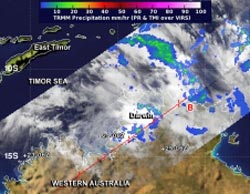NASA Sees Tropical Cyclone Alessia Make Landfall Near Darwin

NASA's TRMM satellite passed over Tropical Storm Alessia on November 24 at 1325 UTC/8:25 a.m. EST and identified mostly light rain from the system (blue) with a small area (green) of moderate rainfall. <br>Image Credit: NASA/SSAI, Hal Pierce<br>
The final warning on the tropical storm was issued on November 24 from the Joint Typhoon Warning Center at 0900 UTC/4 a.m. EST. At that time, Tropical Cyclone Alessia was located near 13.8 south latitude and 129.0 east longitude, about 136 nautical miles/156.5 miles/252 km southwest of Darwin, Australia. Alessia was moving to the east at 15 knots/17.2 mph/27.7 kph and had maximum sustained winds near 35 knots/40 mph/62 kph at the time.
NASA's Tropical Rainfall Measuring Mission or TRMM satellite passed over Tropical Storm Alessia on November 24 at 1325 UTC/8:25 a.m. EST and identified mostly light rain from the system with a small area of moderate rainfall, falling at a rate of 1.18 inch/30 mm per hour.
Cyclone Alessia crossed Australia's Northern Territory coast and made landfall south of Darwin during the night-time hours and quickly dissipated.
The Australian Bureau of Meteorology reported that the Upper Adelaide River, just north of where Alessia made landfall, received tropical-storm-force winds and received about 54 millimeters of rain. No damages were reported.
Text credit: Rob Gutro
NASA's Goddard Space Flight Center
Media Contact
All latest news from the category: Earth Sciences
Earth Sciences (also referred to as Geosciences), which deals with basic issues surrounding our planet, plays a vital role in the area of energy and raw materials supply.
Earth Sciences comprises subjects such as geology, geography, geological informatics, paleontology, mineralogy, petrography, crystallography, geophysics, geodesy, glaciology, cartography, photogrammetry, meteorology and seismology, early-warning systems, earthquake research and polar research.
Newest articles

Superradiant atoms could push the boundaries of how precisely time can be measured
Superradiant atoms can help us measure time more precisely than ever. In a new study, researchers from the University of Copenhagen present a new method for measuring the time interval,…

Ion thermoelectric conversion devices for near room temperature
The electrode sheet of the thermoelectric device consists of ionic hydrogel, which is sandwiched between the electrodes to form, and the Prussian blue on the electrode undergoes a redox reaction…

Zap Energy achieves 37-million-degree temperatures in a compact device
New publication reports record electron temperatures for a small-scale, sheared-flow-stabilized Z-pinch fusion device. In the nine decades since humans first produced fusion reactions, only a few fusion technologies have demonstrated…





















